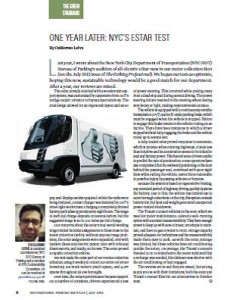Last year, I wrote about the New York City Department of Transportation (NYC DOT) Bureau of Parking’s audition of all-electric eStar vans in our meter collection fleet (see the July 2012 issue of The Parking Professional). We began our tests as optimists, hoping this new, sustainable technology would be a good match for our department. After a year, our reviews are mixed.
The eStar, already outfitted with a wooden slat support system, was customized by carpenters from DOT’s Bridge Repair Division to bureau specifications. The final design allowed for an ergonomic layout and an 80 pay-and-display canister payload. While the racks were being installed, a smart charger was installed by DOT’s street light electricians. Charging a completely drained battery pack takes approximately eight hours. The range of each full charge depends on several factors, but the suggested range is 80 to 100 miles per full charge.
Our concerns about the eStar’s real-world working range limited its initial assignments to those close to the meter collection facility. Without any real range problems, the eStar assignments were expanded, first with tandem diesel and electric power, later with inbound diesel escorts, and finally, on its own. The eStar proved a capable collection vehicle.
We first made the eStar part of our routine collection schedule, using it weekly to collect our entire off-street inventory, 218 muni-meters (multi-space), and 4,277 spaces throughout all five boroughs.
Over time, the eStar’s performance became suspect. On a number of occasions, drivers experienced a loss of power steering. This occurred while pulling away from a dead stop and during normal driving. The power steering failure resulted in the steering wheel feeling very heavy or tight, making responsiveness an issue.
The vehicle is equipped with a continuously variable transmission (CVT) and an E-Brake parking brake, which must be engaged when the vehicle is stopped. Failure to engage this brake results in the vehicle rolling on an incline. There have been instances in which a driver stopped without fully engaging the brake and the vehicle rolled up to several feet.
A fully-loaded eStar proved very slow to accelerate, which is an issue when entering highways. It feels less than intuitive and its acceleration seems to be linked to load and battery power. This has left some drivers unable to predict the rate of acceleration. Some operators have also complained that the awkward positioning of the door behind the passenger seat, combined with poor sight lines while exiting the vehicle, leaves them vulnerable to possible injury by passing vehicles or bicycles.
Because the system is based on regenerative braking, any extended period of highway driving quickly depletes the battery. Due to this, the vehicle has limited use in outer-borough collections. In the city, this system extends battery life, but heat and weight generated unexpected power-related shutdowns.
The Transit Connect vehicles in the fleet, which we used for meter maintenance, offered a well-running option with excellent maneuverability. They have enough power to keep up with flow of traffic, are simple to maintain, and have no gas or water to refill. Storage capacity proved adequate for technicians and the maneuverability made them easy to park. As with the eStar, mileage was limited, but these vehicles have air conditioning (unlike the eStar). On average, the Transit Connects traveled 20 to 25 miles before the meter indicated that a recharge was needed; this distance was shorter with the air conditioning or heat engaged.
The reviews are in and they are mixed, but as long as you are OK with their limitations, both the eStar and Transit Connect Electric are alternatives to thirstier vans.
Guillermo Leiva is assistant commissioner, NYC DOT-Bureau of Parking and a member of IPI’s Sustainability Committee. He can be reached at gleiva@dot.nyc.gov or 718.786.7300.
TPP-2013-07-One Year Later NYC’s EStar Test

